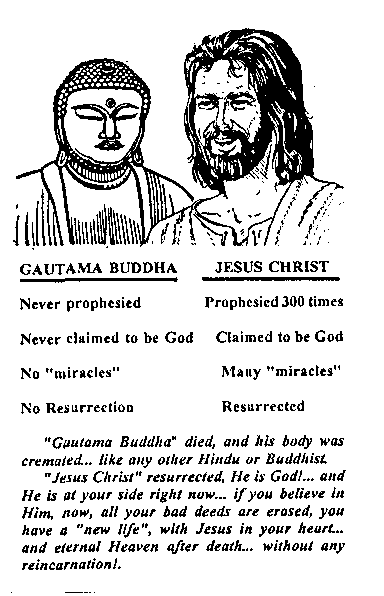There's really no comparison here.
Old names for Buddha
Somonacodom, Sommonokhodom, is a corruption of a Thai name for Buddha. The "Sagomambarlan" of Kubla Khan is also thought to be identified with Gautama Buddha.
Following is a quote from[ http://dsal.uchicago.edu/cgi-bin/philologic/getobject.pl?c.1:1:1.hobson]
GAUTAMA , n.p. The surname, according to Buddhist legend, of the Sakya tribe from which the Buddha Sakya Muni sprang. It is a derivative from Gotama, a name of "one of the ancient Vedic bard-families" (Oldenberg). It is one of the most common names for Buddha among the Indo-Chinese nations. The Sommona-codom of many old narratives represents the Pali form of S'ramaṇa Gautama, "The Ascetic Gautama."
1545. -- "I will pass by them of the sect of Godomem, who spend their whole life in crying day and night on those mountains, Godomem, Godomem, and desist not from it until they fall down stark dead to the ground." -- F. M. Pinto, in Cogan, p. 222.
c. 1590. -- See under Godavery passage from Āīn, where Gotam occurs.
1686. -- "J'ai cru devoir expliquer toutes ces choses avant que de parler de Sommono-<-> khodom (c'est ainsi que les Siamois appellent le Dieu qu'ils adorent à present)."-<-> Voy. de Siam, Des Pères Jesuites, Paris, 1686, p. 397.
1687-88. -- "Now tho' they say that several have attained to this Felicity (Nireupan, i.e. Nirvana) . . . yet they honour only one alone, whom they esteem to have surpassed all the rest in Vertue. They call him Sommona-Codom; and they say that Codom was his Name, and that Sommona signifies in the Balie Tongue a Talapoin of the Woods." -- Hist. Rel. of Siam, by De La Loubere, E.T. i. 130.
[1727. -- ". . . inferior Gods, such as Somma Cuddom. . . ." -- A. Hamilton, ed. 1744, ii. 54.]
1782. -- "Les Pegouins et les Bahmans. . . . Quant à leurs Dieux, ils en comptent sept principaux. . . . Cependant ils n'en adorent qu'un seul, qu'ils appellent Godeman. . . ." -- Sonnerat, ii. 299.
1800. -- "Gotma, or Goutum, according to the Hindoos of India, or Gaudma among the inhabitants of the more eastern parts, is said to have been a philosopher . . . he taught in the Indian schools, the heterodox religion and philosophy of Boodh. The image that represents Boodh is called Gautama, or Goutum. . . ." -- Symes, Embassy, 299.
1828. -- "The titlesorsynonymes of Buddha, as they were given to me, are as follow: "Kotamo (Gautama) . . . Somana-kotamo, agreeably to the interpretation given me, means in the Pali language, the priest Gautama." -- Grawfurd, Emb. to Siam, p. 367.
Buddha's cousin
Buddha's cousin (or brother) Devadatta comes to an interesting end in early Western accounts.
- Bell's New Pantheon Or Historical Dictionary of the Gods
Sommonacodom had a brother named Thevathat, who passed through as many transmigrations as himself, and was always born at the same time with him. Thevathat aspired likewise to divinity, but was always inferior to his brother: however, having a great deal of wit and address, he found means to set up a new sect, and engaged several princes and nations to follow his doctrine; which divided the world into two parties. This opposition to his brother drew a very severe punishment on Thevathat; for when Sommonacodom was become a god, he beheld his brother in one of the regions of hell, nailed to a cross, crowned with thorns, and suffering the cruelest torments...
- A new and general biographical dictionary
As to Thevathat, he was always born again with his brother Sommonokhodom, in the same kind of animals with him; but was always inferior to him in dignity. Yet Thevathat aspired to be a god ; and unable to bear a superior, would never submit to, but conspired against his brother ; and compassed his purpose in some measure, for he killed them when they were both monkeys. The Siamese scriptures, which relate this and more of the fame fort, tell us what kind of punishment Thevathat was made to suffer. He was nailed on cross with large nails, which, being driven through his hands and feet, caused him the most terrible pain ; had a crown of thorns on his head ; had his body covered over with wounds; and, to complete his misery, an eternal fire burning under him without consuming him. i Such accounts are brought us from Siam by father Tachard the Jesuit and others. It can hardly be supposed, but that the Siamese and the Christian religions have had some communication with each other ; fince many particulars indicate it, especially those of the punishment of Thevathat.
![[Everything Shii Knows]](../mediawiki/skins/common/images/wiki.png)
